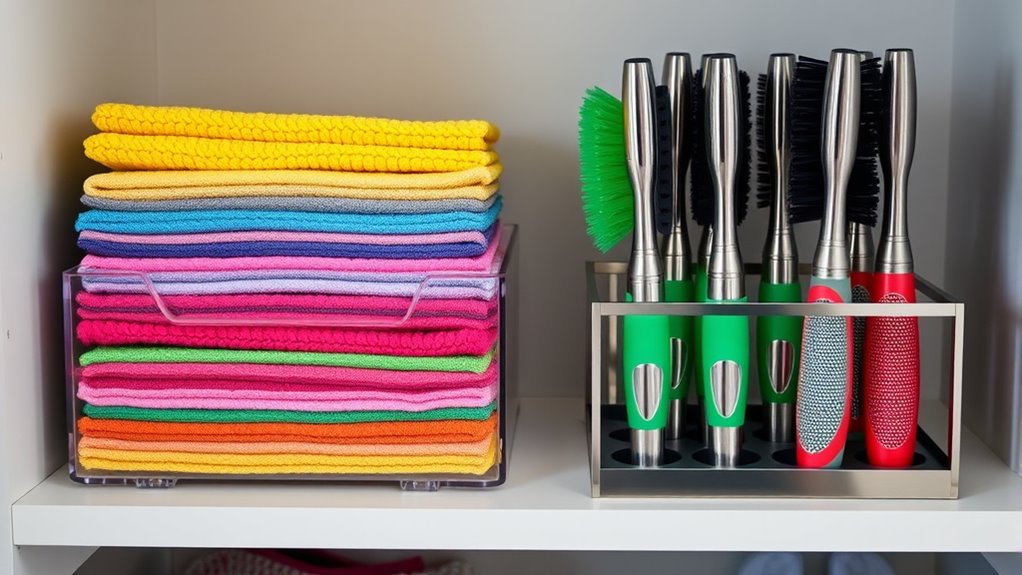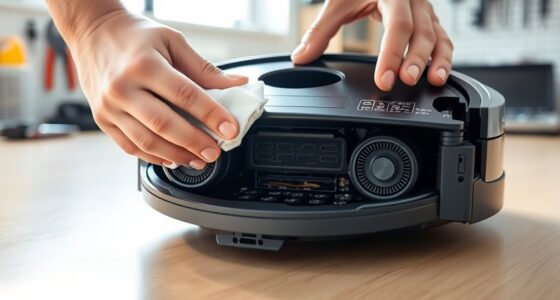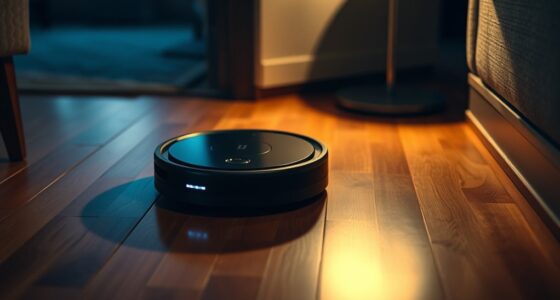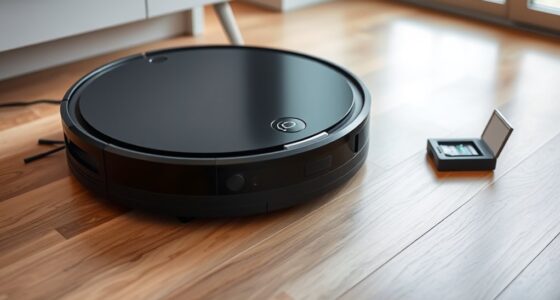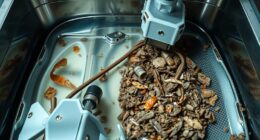To keep your extra mop pads and brushes organized, designate specific storage spots like wall-mounted caddies, labeled bins, or breathable containers. Fold or roll pads to save space and hang brushes by their handles to maintain bristle shape. Regularly inspect and replace worn tools, and guarantee all items are stored dry and off the floor to prevent mold and odors. If you’re interested, you’ll discover more tips to maintain your cleaning tools effectively.
Key Takeaways
- Designate specific labeled containers or sections for storing extra mop pads and brushes.
- Use wall-mounted racks or hooks to hang brushes and roll or fold mop pads for space efficiency.
- Keep microfiber pads and brushes in separate, ventilated storage to prevent mold and odors.
- Regularly inspect and replace worn tools to maintain cleaning effectiveness and hygiene.
- Maintain an organized storage area with designated spots to facilitate easy swapping and access.
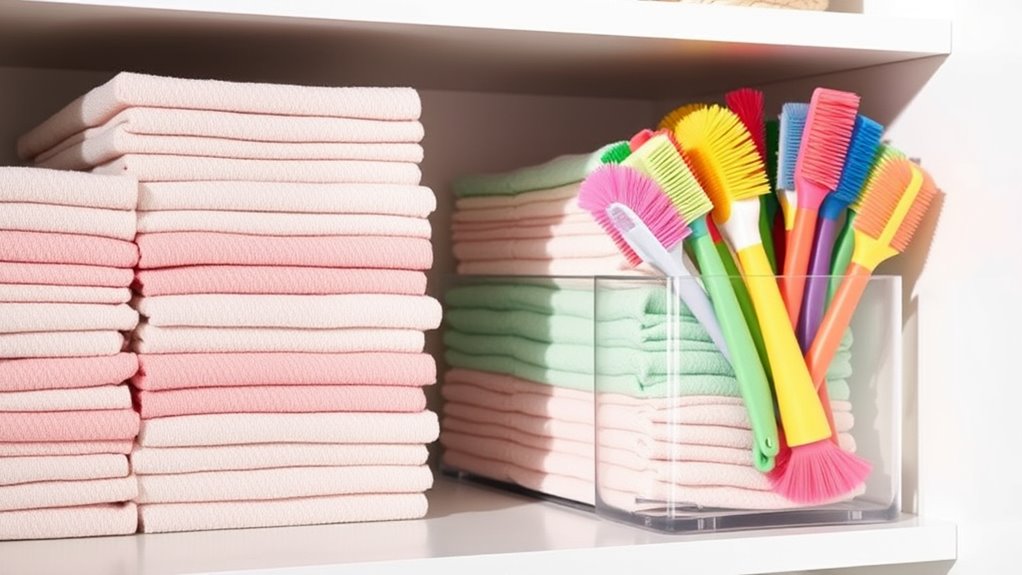
Keeping extra mop pads and brushes organized can make your cleaning routines more efficient and less frustrating. When you have a designated system in place, you spend less time searching for what you need and more time actually cleaning. The key is implementing smart storage solutions that keep everything accessible and tidy. First, consider investing in a wall-mounted caddy or shelving unit designed specifically for cleaning tools. These storage solutions keep your mop pads and brushes off the floor, preventing dirt transfer and damage. Using hooks or racks allows you to hang brushes by their handles, keeping bristles in good shape and ready for use. For mop pads, a breathable container or a dedicated drawer can prevent mustiness and facilitate quick swaps.
When choosing your storage options, think about your space and how often you clean. If you have a small closet or laundry area, stackable bins or wall-mounted organizers work well. Labeling each container or section can streamline your cleaning tips and ensure everyone in your household knows where to find or return tools. Keep in mind that storing wet or damp pads in sealed containers can cause mold and bad odors, so make sure they’re dry before storing or opt for ventilated storage solutions. Regularly inspecting and swapping out old or worn-out mop pads also keeps your cleaning routine fresh and effective.
Another helpful cleaning tip is to designate specific spots for different tools. For example, keep all your microfiber pads in one bin and your brushes in another. This prevents clutter and makes it easier to grab what you need without rummaging through a jumble of supplies. When storing brushes, make sure their bristles aren’t bent or crushed; using a brush holder with individual slots helps maintain their shape. For mop pads, consider folding them neatly or rolling them to save space and keep them organized.
Additionally, choosing hydrogen energy compatible storage solutions can help ensure your cleaning tools remain environmentally friendly and safe. In addition to physical storage, establishing a routine for swapping and cleaning your mop pads and brushes helps maintain hygiene and prolongs their lifespan. After each cleaning session, rinse and dry your brushes thoroughly, then store them in a dry place. Rotate between multiple mop pads so you always have a clean one ready to go, reducing cross-contamination and ensuring a thorough clean every time. By applying these storage solutions and cleaning tips, you’ll make your cleaning routine more streamlined and stress-free. Keeping everything organized means less time searching and more time enjoying a spotless home.
Frequently Asked Questions
How Often Should I Replace My Mop Pads and Brushes?
You should replace your mop pads and brushes based on their lifespan and your cleaning frequency. Typically, a mop pad’s lifespan is about 10-15 washes, but if it shows wear or odor, it’s time for a replacement. For brushes, follow a regular brush replacement schedule, usually every 3-6 months. Regularly inspect your tools to make sure they stay effective, and replace them when they no longer clean properly.
What Materials Are Best for Storing Cleaning Tools?
Think of your storage solutions as a cozy, secure closet for your cleaning tools. Opt for storage containers made of breathable materials like plastic with vented lids or sturdy fabric bins to guarantee good airflow. Prioritize moisture control by choosing containers that prevent dampness, which can lead to mold or odors. This way, your mop pads and brushes stay fresh, dry, and ready for action whenever you need them.
Can I Wash Mop Pads and Brushes in a Dishwasher?
You might wonder if dishwasher cleaning is suitable for mop pads and brushes. While some mop pads can be sanitized in a dishwasher, it’s not always recommended for brushes, as the high heat could damage bristles. Use dishwasher sanitizing methods cautiously, and check manufacturer instructions first. For effective cleaning, consider hand washing with disinfectant or using a steam cleaner to ensure proper sanitizing without risking damage.
How Do I Prevent Mold and Odors in Storage?
Imagine you’re a modern-day Marie Kondo, keeping your space tidy. To prevent mold and odors in storage, make certain your mop pads and brushes are thoroughly dry before storing. Use odor control sachets or baking soda to absorb moisture and smells. Regularly inspect and clean your storage area to boost mold prevention. Proper ventilation is key; keep the space airy to stop mold growth and keep everything fresh and odor-free.
What’s the Ideal Humidity Level for Storing Cleaning Supplies?
You should aim to keep your storage area between 40-50% humidity for ideal storage of cleaning supplies. Proper humidity control prevents mold and odors from developing. Use storage containers with airtight seals to further protect your mop pads and brushes. Regularly check humidity levels with a hygrometer, and consider using dehumidifiers or silica gel packets inside containers to maintain a consistent, perfect environment that keeps your cleaning tools fresh and odor-free.
Conclusion
By swapping and storing your extra mop pads and brushes, you keep your cleaning supplies tidy and ready for use. When you organize efficiently, you save time and prevent clutter from piling up. Think of it like a well-choreographed dance—every item has its place, making your cleaning routine smoother. So, take a moment to set up your storage system today; you’ll find cleaning becomes quicker and more enjoyable, proving that organization truly makes a difference.
